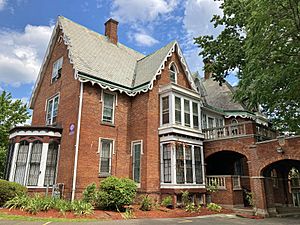John Hooker (abolitionist) facts for kids
John Hooker (1816-1901) was an American lawyer and judge. He also worked to end slavery and supported women's rights.
In 1841, he married Isabella Beecher Hooker. They lived in Farmington and Hartford, Connecticut. In 1853, John Hooker and his brother-in-law, Francis Gillette, bought 140 acres of land. They created a neighborhood in Hartford called "Nook Farm."
Nook Farm became a special community. Many famous writers, politicians, and reformers lived there. Some well-known residents included Harriet Beecher Stowe, Mark Twain, Isabella Beecher Hooker, and Charles Dudley Warner.
Contents
John Hooker's Early Life and Work
John Hooker wrote a book about his life called Some Reminiscences of a Long Life. In it, he shared that his father was Edward Hooker. Edward was a direct descendant of Thomas Hooker. Thomas Hooker was the first minister of the First Church of Hartford. He also helped found Connecticut.
John Hooker's law office was in Farmington in the 1840s. It was on the second floor of a store. His office was next to where some African men from the Amistad ship were held. The Amistad case was a famous legal battle about enslaved people.
John and Isabella Beecher Hooker raised three children. They lived in their home in Nook Farm. This home was at the corner of Forest and Hawthorn Streets.
Supporting Women's Rights
John Hooker strongly supported the women's rights movement. His wife, Isabella, helped him become interested in this cause. He also supported his sister-in-law, Harriet Beecher Stowe. She was just starting her work as an activist.
In 1877, John and Isabella Beecher Hooker wrote "A Woman's Property Bill." This bill was very important for women's rights in Connecticut.
Working to End Slavery
John Hooker was an active abolitionist. This means he worked to end slavery. He used his legal skills to help enslaved people gain freedom.
For example, he helped Reverend James W.C. Pennington become free. Reverend Pennington was an African-American minister. He was enslaved in Maryland. John Hooker helped pay $150 for his freedom. This allowed Reverend Pennington to return from Europe. He could then continue his work as a minister in Hartford.
John Hooker was also the president of an anti-slavery committee in Hartford. He helped organize a "liberty convention" on October 27, 1846. This meeting was about fighting against slavery.
John Hooker was a church leader, called a congregational deacon. He also believed in Spiritualism. This was a movement where people thought they could talk to the spirits of the dead.
Charter Oak Newspaper
The Charter Oak was an anti-slavery newspaper in the 1800s. The Connecticut Anti-Slavery Society of Hartford published it. The newspaper's motto was: "Free Principles–Free Men–Free Speech–And A Free Press." You can find old copies of this newspaper at the Connecticut State Library.
Married Women's Property Act
The Married Women's Property Act was also known as "A Woman's Property Bill." It was a law passed in Connecticut in 1877. This law was a big step forward for women's rights. It aimed to give women more control over their lives and property.
The act allowed married women to control their own property. It also meant they could sue or be sued in court, just like their husbands. This gave women more independence and power within their families.



